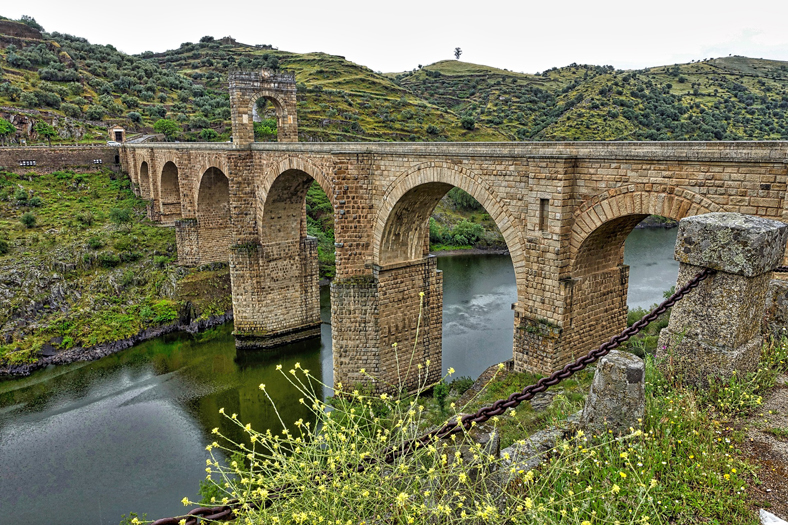The Alcantara Bridge is a Roman stone arch bridge in Spain that spans the Tajo River near the town of the same name in Extremadura, about five kilometers from the Portuguese border. It is considered the most important preserved Roman bridge structure.
The road bridge was built in the first decade of the second century AD, at the time of Emperor Trajan, within about five years. For comparison, building projects of similar size in the Middle Ages often took decades or even centuries. The short construction period was made possible by the high level of logistical organization of the Roman central administration and transport system, which was able to effectively concentrate workers – free workers and slaves – from a huge reservoir in certain locations. The Alcántara bridge was probably completed in AD 105 or 106.
One of the spans, destroyed by the Moors, was rebuilt in 1543. Another span was blown up twice, in 1762 and 1809, both times in order to stop the advance of the enemy army from Portugal to Extremadura. In the past, the bridge was generally of great strategic importance, and the name of the city of Alcantara is translated from Arabic as “bridge”.
At the entrance of the bridge there is a small rectangular pavilion with an inscription that mentions the architect: “The bridge, designed to last forever in the centuries of the world, was made by Lacer, famous for his divine art.” It stands tall, elegant and strong, with expectations of continuing its forever young history.
The village of Alcantara was born years later. As also later the bridge was central to the Military Order of Alcantara in the defense of the village, border with Portugal.
The inclusion of the bridge in the World Heritage of Unesco has been applied for since 1998. In 2013, the Extremadura provincial parliament formed a bipartisan initiative that would revive and promote the process of recognizing the monument. In October 2014,
Access : Coordinates: 39.7224, -6.8924 / Locale : Alcantara, Spain / The Alcantara Bridge is located on the Tagus River, near the town of Alcantara, in Spanish Extremadura.
Highlights :
- Description-Characteristics : The bridge consists of 6 arcs of unequal height, resting on five pedestals at a different height from the ground, consisting of smooth slate. The bridge originally had a length of 190 meters, but today it has been reduced to 181.7 meters. Its width is 8.7 meters. The arcs opening from the right to the left bank are 13.6, 23.4, 28.8, 27.4, 21.9 and 13.8 meters. The maximum height of the arches is 45 meters, without calculating the triumphal arch.
- Roman temple of Alcantara : At the entrance of the bridge from Alcantara there is a Roman temple made entirely of stone and covered with two slopes. It has two columns of Tuscan order on the facade and inside there are remains that seem to indicate an old internal division in naos and pronaos.
- architecture prize : Since 1988, a foundation has awarded the international architecture prize Premio Internacional Puente de Alcantara every two years, with which “under the sign of this Roman bridge, engineering structures of outstanding cultural, technical, aesthetic or social importance in Spain, Portugal and Latin America are to be awarded”
- There is a memorial shrine with a triumphal arch in the center of the bridge, 10 meters high, dedicated to Trajan. The bridge is made of granite blocks measuring 45 by 55 cm. In addition, at the base of the bridge is a Roman temple dedicated to the builder, called Lasserre, and christened in the Middle Ages by the name of San Julian with the addition of a bell tower and a granite cross. There is buried his manufacturer, Gaius Julius Lasser.
- inscription : On the arch above the central podium is a Roman inscription that reads: “Pontem perpetui mansurum in saecula” (I built this bridge to last forever).
Activities : sightseeing / photo opportunities- Photography, Architecture Photography / Scenic Driving- Auto Touring / Ancient Culture Study
Go next : The village of Alcantara / Brozas Historical Set / Royal Monastery of Guadalupe World Heritage Site / Roman ruins of Augustobriga / Historical Set of Valverde de La Vera
Valverde is a municipality of Caceres located in the district of La Vera.

